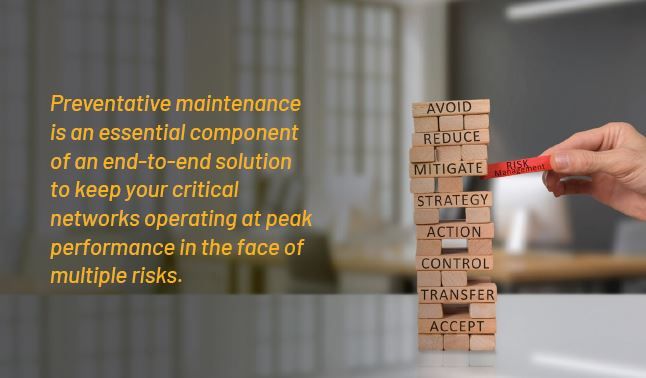No Crystal Ball Required
Business continuity has fast become a non-negotiable factor for organisations. With access to more data recording, analysis and modelling than ever before, the actual costs of operational downtime in resources, time, money and opportunity are highly measurable.
Acknowledging these costs comes hand-in-hand with uncovering and recognising risks - and there is no bigger threat to productivity and profitability than power loss or interruption.
No longer just a case of the monitors going dark, machinery grinding to a halt and everyone taking an early lunchbreak – there are continuously evolving risks to the safety of your people, the security of your data and the resilience of your critical processes and infrastructure.
More worryingly, as your assets and capability evolves, steps that you may have taken in the past to mitigate acknowledged risks may not necessarily deliver the expected protection when called upon.
“Ongoing risk evaluation and preventative maintenance is essential to achieving optimal and consistent performance.”
Bypass mode and you
Has the UPS that sits in the corner of your office, or the one that has been a part of your server room for the last 5 years switched to bypass mode?
Would you know if it had?
We encounter dozens of scenarios where the correct initial steps had been taken and installed UPS systems appear to be in working order for several months right up until the point where they must perform – and then the costs of a power event begin to stack up.
UPSs have components that require regular maintenance like the brake pads on your car. If an older component fails, the UPS could (and should) switch to bypass mode, maintaining your flow of power, but if this flow is interrupted your whole operation is no longer running.
Great initial intentions don’t mean as much if they aren’t accompanied by good system design and regular testing. Your business simply can’t afford to wait for problems to arise before taking action: preventive maintenance is critical to uptime and to protecting sensitive electronics.
Maintaining Risk Mitigation
The excellent news is that as the risks to your productivity evolve, so do the solutions designed to mitigate them. You may not be able to do much about natural disasters, but you can take steps to enhance the return on investment on your UPS equipment by maximising its reliability and service life.
“Two-thirds of downtime events are preventable.”
Recognised global manufacturers make sure that “best-in-class” means something. Constant analysis of power trends and their causes world-wide are designed to ensure you avoid any and all unnecessary preventable downtime.
Insufficient maintenance is among the chief causes of production interruption and analysis of thousands of installations across millions of operating hours has proven that UPS systems that receive preventative maintenance twice per year are 20 times less likely to fail when called upon.
Detecting and repairing problems before they evolve into significant and costly issues, ensures your UPS will deliver the level of performance you require. Systematic inspections, testing and cleaning by trained technicians will ensure the various electronic and mechanical components of your UPS are functioning to maximum potential.
Your operation deserves the best
When you install a UPS system and deploy a tailored and robust preventative maintenance strategy, what you are actually purchasing is assurance.
Thanks to the increased visibility provided by advanced data analysis tools, the assurance of business continuity and productivity is absolutely measurable. This enables you to build a very compelling business case for the protection of your staff, assets and processes.
A vital element is the expertise you bring in to deliver this assurance.
Factory trained UPS engineers are able to see your operation as a unique instance, meaning that there is simply no ‘cookie-cutter’ solution to power protection.
The factors and considerations of any site can change rapidly and being able to adapt, not only equipment, but the manner in which that equipment should be maintained is best done by professionals – so make sure you choose the right partner to deliver you this assurance long-term.
An effective preventive maintenance strategy can be the most cost-effective measure you can take to ensure the ongoing health of both your critical equipment and overall business.
Regular maintenance practices dramatically improve UPS reliability and performance, while notably deterring downtime. Preventive maintenance is an essential component of an end-to-end solution to keep your critical networks operating at peak performance in the face of multiple risks.


